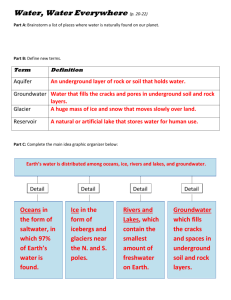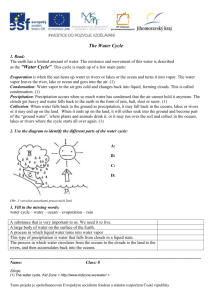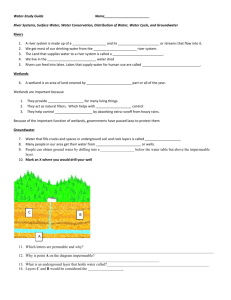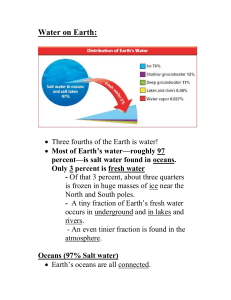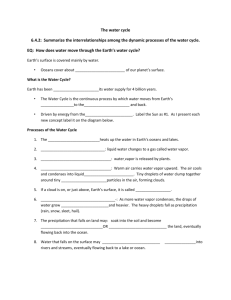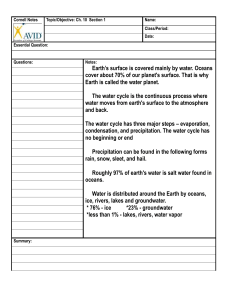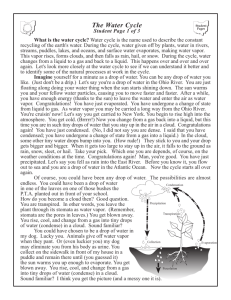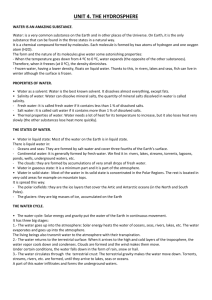How Much Usable Water Really Is There?
advertisement
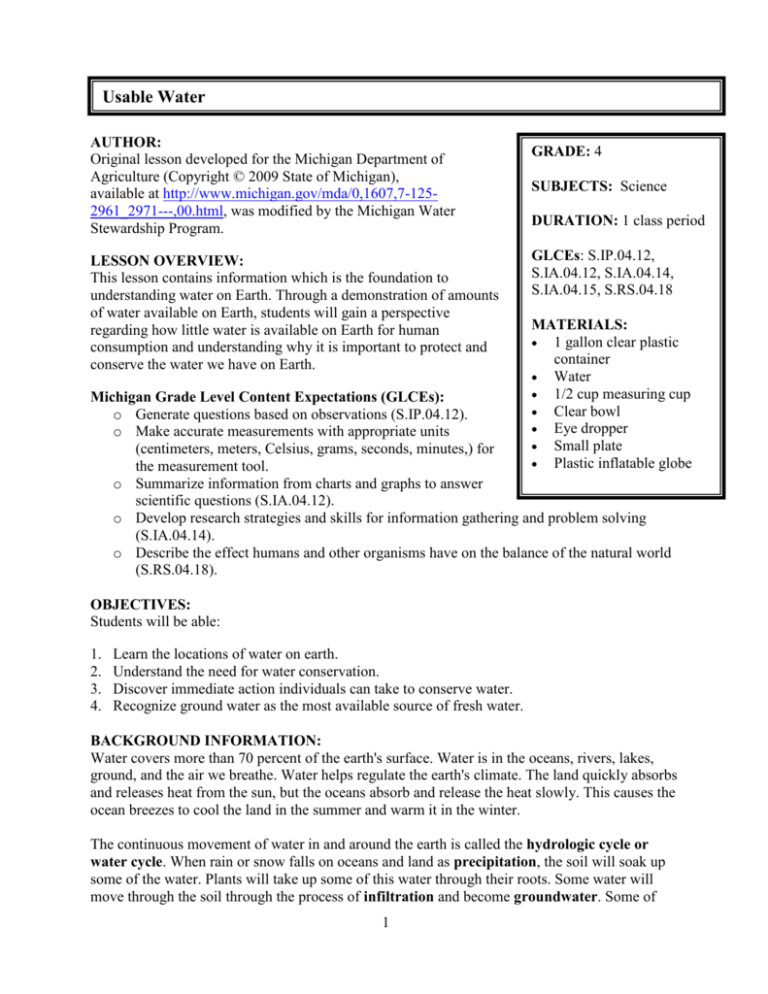
Usable Water AUTHOR: Original lesson developed for the Michigan Department of Agriculture (Copyright © 2009 State of Michigan), available at http://www.michigan.gov/mda/0,1607,7-1252961_2971---,00.html, was modified by the Michigan Water Stewardship Program. LESSON OVERVIEW: This lesson contains information which is the foundation to understanding water on Earth. Through a demonstration of amounts of water available on Earth, students will gain a perspective regarding how little water is available on Earth for human consumption and understanding why it is important to protect and conserve the water we have on Earth. GRADE: 4 SUBJECTS: Science DURATION: 1 class period GLCEs: S.IP.04.12, S.IA.04.12, S.IA.04.14, S.IA.04.15, S.RS.04.18 MATERIALS: 1 gallon clear plastic container Water 1/2 cup measuring cup Clear bowl Eye dropper Small plate Plastic inflatable globe Michigan Grade Level Content Expectations (GLCEs): o Generate questions based on observations (S.IP.04.12). o Make accurate measurements with appropriate units (centimeters, meters, Celsius, grams, seconds, minutes,) for the measurement tool. o Summarize information from charts and graphs to answer scientific questions (S.IA.04.12). o Develop research strategies and skills for information gathering and problem solving (S.IA.04.14). o Describe the effect humans and other organisms have on the balance of the natural world (S.RS.04.18). OBJECTIVES: Students will be able: 1. 2. 3. 4. Learn the locations of water on earth. Understand the need for water conservation. Discover immediate action individuals can take to conserve water. Recognize ground water as the most available source of fresh water. BACKGROUND INFORMATION: Water covers more than 70 percent of the earth's surface. Water is in the oceans, rivers, lakes, ground, and the air we breathe. Water helps regulate the earth's climate. The land quickly absorbs and releases heat from the sun, but the oceans absorb and release the heat slowly. This causes the ocean breezes to cool the land in the summer and warm it in the winter. The continuous movement of water in and around the earth is called the hydrologic cycle or water cycle. When rain or snow falls on oceans and land as precipitation, the soil will soak up some of the water. Plants will take up some of this water through their roots. Some water will move through the soil through the process of infiltration and become groundwater. Some of 1 the water will also run-off or across the land into streams, marshes, lakes, and oceans. The water that remains on top of the earth is called surface water. Surface water will return to the atmosphere through evaporation. Water vapor in the air may form clouds that cause precipitation (rain or snow) to occur again. The precipitation then returns to the earth's surface. This is a continuous cycle. Life is not possible without water. Water is in every living thing. Our body is nearly 65 percent water. An ear of corn is nearly 70 percent water, a potato is about 80 percent, and a tomato is about 95 percent. In order for living things to carry out life processes, we must keep our water supply clean and healthy. We can live without food for two months, but we cannot live without water for more than a week. Many people believe there is not enough water to meet all the needs of the people throughout the world. Yet, the world will always have the same amount of water because of the water cycle. However, the world's water is unevenly distributed. Some places that have plenty of water go through a drought at times and other places go through a constant drought. We must manage our water quality and supply carefully so it remains safe and plentiful to use. Many conservation problems are due to mismanagement of our water supply. Over many years, people have dumped untreated sewage and other wastes into lakes and rivers. This contaminates the water. More and more people now realize we have to take special care of our water to ensure its quality, not only for now, but for the future. Although 70 percent of the earth is water, nearly 97 percent is in the oceans. Ocean water is too salty for drinking, manufacturing, and farming. The fresh water available for us to use is about three percent of the earth's water supply. Three-fourths of the three percent fresh water is unavailable because it is in icecaps and other glaciers. VOCABULARY: Climate, hydrologic cycle/water cycle, precipitation , atmosphere, evaporation, infiltration, water vapor, precipitation, drought, conservation, contaminates, sewage, icecaps, glaciers, surface water, groundwater, run-off, water conservation. PROCEDURE: Warm-Up (Anticipatory Set): How Much Water do You Use in a Day? Prior to the lesson, ask students to make a list of all the water that they use in one 24-hour period of time. Have students measure or estimate amounts of water used. Discuss results as a class. What were the commons uses of water? Who used the most water? Who used the least water? Most likely students accounted for obvious uses like the amount of water they used to brush their teeth and drink. What about indirect uses of water, such as the water used to process the food they ate, and the water used in our home for cooking, bathing and flushing the toilet? What are ways to reduce the amount of water used every day? Globe Toss. To help students visualize all the water in the world and how very little of it is available for drinking, toss around an inflatable globe. Repeat this 100 times. Each time the student catches the globe, ask them to tell the class what their right thumb is 2 touching. Is it land or water? If it is water, what kind of water and is it drinkable? Record this information on the chalkboard or white board. Your results should more or less indicate that 70% of the time, thumbs will touch water and 30% land. As far as freshwater and saltwater goes, the type of water touched will largely be saltwater tied up in oceans. Activity This table shows the distribution of Earth's water supply. Share this information with your students. Location of Water Supply: Source Oceans Ice Groundwater Soil Moisture Atmosphere Inland Lakes Rivers % of Water Supply 97.3% 2.19% 0.5% 0.005% 0.001% 0.018% 0.000096% To demonstrate how much of the earth's water supply is actually usable, ask students to help you with the following activity. Make sure students understand this is a demonstration and there is actually more water than this on earth. a. Pour water into a one-gallon container, such as a plastic ice cream bucket. This represents all the water on Earth. b. Pour a half-cup of water out of the one-gallon container and into a clear bowl. The water in the bowl represents all of the fresh water on earth, which is less than three percent of the total water on earth. Fresh water is found in lakes, rivers, groundwater, ice, and living things. The 15 1/2 cups that are still in the one-gallon container represent salt water. We cannot use salt water. c. With an eyedropper, release one drop of water from the half-cup onto a small plate. This one drop represents the freshwater that is available for our use. This water is found in rivers and lakes. The rest of the water in the half-cup is deep groundwater, bound up as soil moisture, biomass water, or water in the atmosphere. Wrap-Up (Closure): Though water covers over 70% of the surface of the Earth, most of this water is not suitable for drinking. What would happen if there was a shortage of water? How might this affect the Great Lakes, which contains 20% of the world’s freshwater supply? ASSESSMENT OPTION: 1. Describe the water cycle. 2. Where is the least/most water? 3. Which source is the least/most usable by living things? 4. Which source is most readily available? 5. How can you and your family conserve water at home? 6. What can farmers do to conserve water for plant and animal use? 7. Why is water important? 3 EXTENSIONS: Have students make a visual display showing the distribution of water on earth. Introduce the water cycle. Ask students to place the location of water on a diagram they make of the water cycle. Assign individuals or groups of students the task of making a poster to encourage others to practice water conservation. Display these posters in the hallways or in the community (grocery store, bank, library, etc.) so many will see them. RESOURCES: EPA Water Sense Kids Web Site: http://www.epa.gov/watersense/kids/simpleways.html USGS Water Science For Schools: http://ga.water.usgs.gov/edu/index.html EPA Magnificent Groundwater Connection: http://www.epa.gov/ne/students/teacher/groundw.html 4
